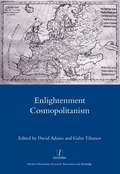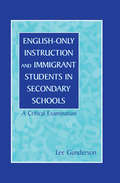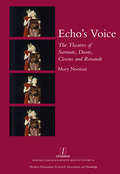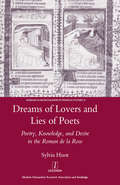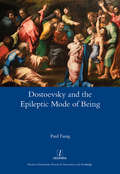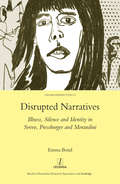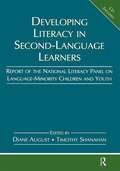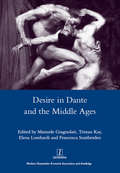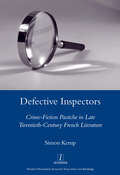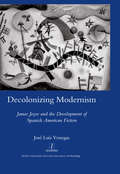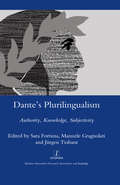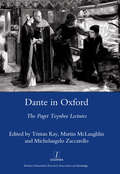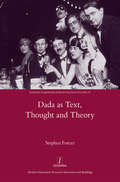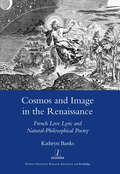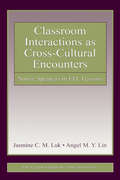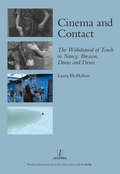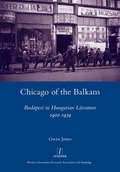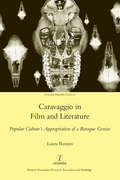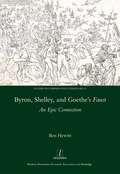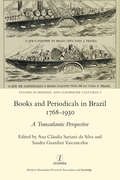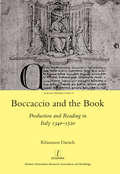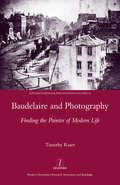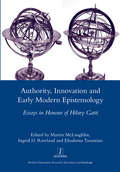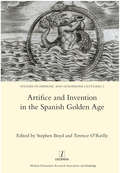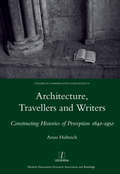- Table View
- List View
Enlightenment Cosmopolitanism
by David AdamsEnlightenment Cosmopolitanism brings together ten innovative contributions by outstanding scholars working across a wide array of disciplines in the humanities and social sciences. Interdisciplinary in its methodology and compass, with a strong comparative European dimension, the volume examines discourses ranging from literature, historiography, music and opera to anthropology and political philosophy. It makes an original contribution to the study of 18th-century ideas of universal peace, progress and wealth as the foundation of future debates on cosmopolitanism. At the same time, it analyses examples of counter-reaction to these ideas and discusses the relevance of the Enlightenment for subsequent polemics on cosmopolitanism, including 21st-century debates in sociology, politics and legal theory.
English-Only Instruction and Immigrant Students in Secondary Schools: A Critical Examination
by Lee GundersonThis book is for teachers, teacher educators, school and district administrators, policy makers, and researchers who want to know about literacy, cultural diversity, and students who speak little or no English. It offers a rich picture of the incredible diversity of students who enter secondary school as immigrants—their abilities, their needs, and their aspirations. The studies reported are part of a large longitudinal study of about 25,000 immigrant students in a district in which the policy is English-only instruction. These studies:*provide multiple views of the students’ lives and their success in schools where the language of instruction differs from the languages they speak with their friends and families;*explore the students’ views of teaching and learning; *describe the potential differences between the students views and those of their teachers; *look at issues related to students’ views of their identities as they work, study, and socialize in a new environment; and*examine different reading models designed to facilitate the learning of English as a second language (ESL). Educators and researchers will find the descriptions of students’ simultaneous learning of English and of academic content relevant to their view of whether instruction should be English only or bilingual. For teachers who view multicultural education as an important endeavor, this book may on occasion surprise them and at other times confirm their views. The author does not attempt to develop a particular political viewpoint about which approach works best with immigrant students. Rather, the objective of the studies was to develop a full, rich description of the lives of immigrant high school students enrolled in classes where the medium of instruction is English. The reader is left to evaluate the results.
Echo's Voice: The Theatres of Sarraute, Duras, Cixous and Renaude
by Mary NoonanHelene Cixous (1937-), distinguished not least as a playwright herself, told Le Monde in 1977 that she no longer went to the theatre: it presented women only as reflections of men, used for their visual effect. The theatre she wanted would stress the auditory, giving voice to ways of being that had previously been silenced. She was by no means alone in this. Cixous's plays, along with those of Nathalie Sarraute (1900-99), Marguerite Duras (1914-96), and Noelle Renaude (1949-), among others, have proved potent in drawing participants into a dynamic 'space of the voice'. If, as psychoanalysis suggests, voice represents a transitional condition between body and language, such plays may draw their audiences in to understandings previously never spoken. In this ground-breaking study, Noonan explores the rich possibilities of this new audio-vocal form of theatre, and what it can reveal of the auditory self.
Dreams of Lovers and Lies of Poets: Poetry, Knowledge and Desire in the "Roman De La Rose"
by Sylvia HuotThe Roman de la Rose explicitly offers an 'art of love', while also repeatedly asserting that the experience of love is impossible to put into words. An examination of the intertextual density of the Rose , with its citations and adaptations of a range of Latin authors, shows that the discourse of bodily desire, pleasure, and trauma emerges indirectly from the juxtaposition and conflation of sources. Huot's new book focuses on Guillaume de Lorris's use of the Ovidian corpus, and on Jean de Meun's dazzling orchestration of allusions to a wider range of Latin writers: principally Ovid, Boethius, and Virgil, but also including John of Salisbury and Alain de Lille. In both parts of the Rose , poetic allegory is a language that can express the unspeakable and the ineffable.
Dostoevsky and the Epileptic Mode of Being
by Paul FungFor Fyodor Dostoevsky (1821-81), who lived with epileptic seizures for more than thirty years, illness is an ineradicable part of existence. Epilepsy in his writings denotes both a set of physical symptoms and a state of survival in which the protagonists incessantly try to articulate, theorize, or master what is ungraspable in their everyday experience. Their attempts to deal with what they cannot control or comprehend results in disappointment, or what Dostoevsky called a mystical terror. Dostoevsky's heroes are unable fully to understand this state, and their existence becomes 'epileptic' in so far as self-knowledge and self-coincidence are never achieved. Fung explores new critical pathways by reexamining five of Dostoevsky's post-Siberian novels. Drawing on insights from writers including Benjamin, Blanchot, Freud, Lacan and Nietzsche, the book takes epilepsy as a trope for discussing the unspeakable moments in the texts, and is intended for students and scholars who are interested in the subject of modernity, critique of the visual, and dialogues between philosophy and literature. Paul Fung is Assistant Professor in English at Hang Seng Management College, Hong Kong.
Disrupted Narratives: Illness, Silence and Identity in Svevo, Pressburger and Morandini
by Emma BondIf Madame Bovary's death in Flaubert's 1857 novel marked the definitive end of the Romantic vision of literary disease, then the advent of psychoanalysis less than half a century later heralded an entirely new set of implications for literature dealing with illness. The theorization of a potential unconscious double (capable of expressing the body, and thus also the intimate damage caused by disease) in turn suggested a capacity to subvert or destabilize the text, exposing the main thread of the narrative to be unreliable or self-conscious. Indeed, the authors examined in this study (Italo Svevo (1861-1928), Giorgio Pressburger (1937-) and Giuliana Morandini (1938-)) all make use of individual 'infected' or suppressed voices within their texts which unfold through illness to cast doubt on a more (conventionally) dominant narrative standpoint. Applying the theories of Freud and more recent writings by Julia Kristeva, Bond offers a new critical reading of the literary function of illness, a function related to the very nature of narration itself.
Developing Literacy in Second-Language Learners: Report of the National Literacy Panel on Language-Minority Children and Youth
by Diane August Timothy ShanahanThis volume reports the findings of the National Literacy Panel on Language-Minority Children and Youth. The formal charge to the panel—a distinguished group of expert researchers in reading, language, bilingualism, research methods, and education—was to identify, assess, and synthesize research on the education of language-minority children and youth with respect to their attainment of literacy. Funding for the project was provided to the Center for Applied Linguistics and SRI International by the U.S. Department of Education’s Institute of Education Sciences and the Office of English Language Acquisition, with additional funding from the National Institute of Child Health and Human Development provided through the U.S. Department of Education. The authors review the state of knowledge on the development of literacy in language-minority children and youth, organized around five specific themes:*Development of Literacy in Second-Language Learners;*Cross-linguistic Relationships in Second-Language Learners;*Sociocultural Contexts and Literacy Development*Educating Language-Minority Students: Instruction and Professional Development; and*Student Assessment Each part begins with a synthesis chapter that spells out the research questions for the chapters in that part, provides background information, describes the methodology used, summarizes the empirical findings reported, addresses methodological issues, and makes recommendations for future research. The following chapters provide more detail on the individual studies reviewed for specific research questions. The volume includes two opening chapters, “Introduction and Methodology” and “Demographic Overview”; a closing chapter that summarizes the report, identifies cross-cutting themes, and makes recommendations for future research; and a CD-ROM providing a searchable database of research references. The audiences for this volume include researchers interested in the development of literacy in language-minority children and youth as well as those studying literacy more generally, and those concerned with improving the education of this population of students.
Desire in Dante and the Middle Ages
by Manuele GragnolatiThis volume takes Dante's rich and multifaceted discourse of desire, from the Vita Nova to the Commedia, as a point of departure in investigating medieval concepts of desire in all their multiplicity, fragmentation and interrelation. As well as offering several original contributions on this fundamental aspect of Dante's work, it seeks to situate the Florentine more effectively within the broader spectrum of medieval culture and to establish greater intellectual exchange between Dante scholars and those from other disciplines. The volume is also notable for its openness to diverse critical and methodological approaches. In considering the extent to which modern theoretical paradigms can be used to shed light upon the Middle Ages, it will interest those engaged with questions of critical theory as well as medieval culture.
Defective Inspectors: Crime-fiction Pastiche In Late Twentieth-century French Literature
by Simon KempCrime fiction is a popular target for literary pastiche in France. From the nouveau roman and the Oulipo group to the current avant-garde, writers have seized on the genre to exploit it for their own ends, toying with its traditional plots and characters, and exploring its preoccupations with perception, reason and truth. In the first full-length study of the phenomenon, Simon Kemp's investigation centres on four major writers of the twentieth century, Alain Robbe-Grillet (b. 1922), Michel Butor (b. 1926), Georges Perec (193682) and Jean Echenoz (b. 1947). Out of their varied encounters with the genre, from deconstruction of the classic detective story to homage to the roman noir, Kemp elucidates the complex relationship between the pasticheur and his target, which demands an entirely new assessment of pastiche as a literary form.
Decolonizing Modernism: James Joyce and the Development of Spanish American Fiction
by JoseLuis VenegasJames Joyce's Ulysses (1922) has been recognized as a central model for the Spanish American 'New Narrative'. Joyce's linguistic and technical influence became the unequivocal sign that literature in Spanish America had definitively abandoned narrow regionalist concerns and entered a global literary canon. In this bold and wide-ranging study, Jose Luis Venegas rethinks this evolutionary conception of literary history by focusing on the connection between cultural specificity and literary innovation. He argues that the intertextual dialogue between James Joyce and prominent authors such as Argentines Jorge Luis Borges and Julio Cortazar, Cuban Guillermo Cabrera Infante, and Mexican Fernando del Paso, reveals the anti-colonial value of modernist form. Venegas explores the historical similarities between Joyce's Ireland during the 1920s and Spanish America between the 1940s and 70s to challenge depoliticized interpretations of modernist aesthetics and propose unsuspected connections between formal experimentation and the cultural transformations demanded by decolonizing societies. Jose Luis Venegas is Visiting Assistant Professor of Spanish at the University of North Carolina at Greensboro.
Dante's Plurilingualism: Authority, Knowledge, Subjectivity
by Sara FortunaDante's conception of language is encompassed in all his works and can be understood in terms of a strenuous defence of the volgare in tension with the prestige of Latin. By bringing together different approaches, from literary studies to philosophy and history, from aesthetics to queer studies, from psychoanalysis to linguistics, this volume offers new critical insights on the question of Dantes language, engaging with both the philosophical works characterized by an original project of vulgarization, and the poetic works, which perform a new language in an innovative and self-reflexive way. In particular, Dantes Plurilingualism explores the rich and complex way in which Dantes linguistic theory and praxis both informs and reflects an original configuration of the relationship between authority, knowledge and identity that continues to be fascinated by an ideal of unity but is also imbued with a strong element of subjectivity and opens up towards multiplicity and modernity.
Dante in Oxford: The Paget Toynbee Lectures 1995-2003 (Oxford Modern Languages And Literature Monographs)
by Tristan KayThe Paget Toynbee lectures on Dante have taken place in Oxford since the mid-1990s. Named after the great medieval scholar of the first half of the twentieth century, they have been delivered by the major Dante experts of our time. This volume gathers together twelve of the most significant lectures, given by internationally renowned scholars such as Zygmunt Baranski, John Barnes, Lino Leonardi, Emilio Pasquini, Michelangelo Picone, Jonathan Usher and the late Peter Armour. The topics range from key questions such as Dante, Ovid and the poetry of exile, to ground-breaking work on obscenity in the Divine Comedy .
Dada as Text, Thought and Theory
by Stephen ForcerThe Dada movement, revered as perhaps the purest form of cultural subversion and provocation in 20th-century Europe, has been a victim of the readiness with which cultural historians have swallowed its own propaganda. Based on extensive close analysis of French-language Dada work in its original form, and offering English translations throughout, this major reappraisal looks at a broad range of media and topics - including poetry, film, philosophy, and quantum physics - in order to get beyond Dada's typecasting as avant-garde anti-hero. Work by women writers and other marginalized figures combines with that of canonical Dadaists to present Dada in a radically new set of guises: poetic and textually subtle; intellectually and philosophically meaningful; peaceable and quasi-Buddhist; and, perhaps most uncomfortably of all, conformist and reactionary.
Cosmos and Image in the Renaissance: French Love Lyric and Natural-philosophical Poetry
by Kathryn BanksRenaissance images could be real as well as linguistic. Human beings were often believed to be an image of the cosmos, and the sun an image of God. Kathryn Banks explores the implications of this for poetic language and argues that linguistic images were a powerful tool for rethinking cosmic conceptions. She reassesses the role of natural-philosophical poetry in France, focusing upon its most well-known and widely-read exponent, Guillaume de Saluste Du Bartas.Through a sustained analysis of Maurice Sceve's Delie , Banks also rethinks love lyric's oft-noted use of the beloved as image of the poet. Cosmos and Image makes an original contribution to our understanding of Renaissance thinking about the cosmic, the human, and the divine. It also proposes a mode of reading other Renaissance texts, and reflects at length upon the relation of 'literature' to history, to the history of science, and to political turmoil.
Classroom Interactions as Cross-Cultural Encounters: Native Speakers in EFL Lessons (ESL & Applied Linguistics Professional Series)
by Jasmine C. Luk Angel M. LinClassroom Interactions as Cross-Cultural Encounters is about native English speakers teaching English as a global language in non-English speaking countries. Through analysis of naturally occurring dialogic encounters, the authors examine the multifaceted ways in which teachers and students utilize diverse communicative resources to construct, display, and negotiate their identities as teachers, learners, and language users, with different pedagogic, institutional, social, and political implications. A range of issues in applied linguistics is addressed, including linguistic imperialism, post-colonial theories, micropolitics of classroom interaction, language and identity, and bilingual classroom practices. Intended to help TESOL professionals of different cultural backgrounds, working in different sociocultural contexts, to critically understand how non-assimilationist, dialogic intercultultural communication with students can be achieved and built on for mutual cultural and linguistic enrichment and empowerment, this book:*emphasizes the sociocultural meanings and micropolitics of classroom interactions that reveal the complex realities of power and identity negotiations in cross-cultural interactions in ELT (English Language Teaching) classroom contexts;*revisits and reconstitutes the notion of native-speakerness and repositions the roles of native and non-native English teachers in the TESOL profession in the contexts of decolonization and globalization; *highlights the need to mobilize intercultural communicative resources for global communication;*addresses two major concerns of EFL (English as a Foreign Language) classroom researchers and teachers: student resistance and learning motivation; and*examines and analyzes the changing ideologies (both explicit and implicit) of teachers and students about English learning in the context of a post-colonial society, and how these ideologies are being enacted, reproduced, but also sometimes contested in EFL classroom interactions. Each chapter includes Questions for Reflection and Discussion to promote critical thinking and understanding of the issues discussed. Tuning-In discussion questions are provided in the three chapters on classroom data analysis to activate readers interpretive schemas before they examine the actual classroom episodes. The data are from an ethnographic study in post-colonial Hong Kong secondary schools involving four native English-speaker teachers and two bilingual Cantonese-English speaking teachers engaged in intercultural classroom dialogues with their Cantonese Hong Kong students. The rich, naturally occurring classroom data and in-depth analyses provide useful pedagogical materials for courses in EFL teacher education programs on classroom discourse analysis from sociocultural perspectives.
Cinema and Contact: The Withdrawal of Touch in Nancy, Bresson, Duras and Denis
by Laura McMahonDrawing on the work of contemporary French philosopher Jean-Luc Nancy, Cinema and Contact investigates the aesthe-tics and politics of touch in the cinema of three of the most prominent and distinctive filmmakers to have emerged in France during the last fifty years: Robert Bresson, Marguerite Duras and Claire Denis. Countering the domi-nant critical account of touch elaborated by recent models of embodied spectatorship, this book argues that cinema offers a privileged space for understanding touch in terms of spacing and withdrawal rather than immediacy and continuity. Such a deconstructive configuration of touch is shown here to have far-reaching implications, inviting an innovative rethinking of politics, aesthetics and theology via the textures of cinema. The first study to bring the thought of Nancy into sustained dialogue with a series of detailed analyses of films, Cinema and Contact also forges new interpretative perspectives on Bresson, Duras and Denis, tracing a compelling two-way exchange between cinema and philosophy.
Chicago of the Balkans: Budapest in Hungarian Literature 1900-1939
by Gwen JonesAt the point of its creation in 1873, Budapest was intended to be a pleasant rallying point of orderliness, high culture and elevated social principles: the jewel in the national crown. From the turn of the century to World War II, however, the Hungarian capital was described, variously, as: Judapest, the sinful city, not in Hungary, and the Chicago of the Balkans. This is the first English-language study of competing metropolitan narratives in Hungarian literature that spans both the liberal late Habsburg and post-liberal, 'Christian-national' eras, at the same time as the 'Jewish Question' became increasingly inseparable from representations of the city. Works by writers from a wide variety of backgrounds are discussed, from Jewish satirists to icons of the radical Right, representatives of conservative national schools, and modernist, avant-garde and 'peasantist' authors. Gwen Jones is Hon. Research Associate at the Department of Hebrew and Jewish Studies, University College London.
Caravaggio in Film and Literature: Popular Culture's Appropriation of a Baroque Genius
by Laura RoratoAlthough fictional responses to Caravaggio date back to the painter's lifetime (1571-1610), it was during the second half of the twentieth century that interest in him took off outside the world of art history. In this new monograph, the first book-length study of Caravaggio's recent impact, Rorato provides a panoramic overview of his appropriation by popular culture. The extent of the Caravaggio myth, and its self-perpetuating nature, are brought out by a series of case studies involving authors and directors from numerous countries (Italy, Great Britain, America, Canada, France and Norway) and literary and filmic texts from a number of genres - from straightforward tellings of his life to crime fiction, homoerotic film and postcolonial literature.
Byron, Shelley and Goethe's Faust: An Epic Connection
by Ben HewittThe first part of Goethe's dramatic poem Faust (1808), one of the great works of German literature, grabbed the attention of Byron and Percy Shelley in the 1810s, engaging them in a shared fascination that was to exert an important influence over their writings. In this comparative study, Ben Hewitt explores the links between Faust and Byron's and Shelley's works, connecting Goethe and the two English Romantic poets in terms of their differing, intricately related experiments with epic. In so doing, Hewitt enters the three writers into a literary and philosophical dialogue concerning 'epic' and 'tragic' perspectives on human knowledge and potential - perspectives crucial to the very structure and significance of Goethe's masterpiece - and illuminates hitherto unacknowledged affinities between these key figures in Romantic literature, and between British and German Romanticisms.
Books and Periodicals in Brazil 1768-1930
by AnaClaudiaSurianiDa SilvaBefore the Portuguese Royal Court moved to its South-American colony in 1808, books and periodicals had a very limited circulation there. It was only when Brazilian ports were opened to foreign trade that the book trade began to flourish, and printed matter became more easily available to readers, whether for pleasure, for instruction or for political reasons. This book brings together a collection of original articles on the transnational relations between Brazil and Europe, especially England and France, in the domain of literature and print culture from its early stages to the end of the 1920s. It covers the time when it was forbidden to print in Brazil, and Portugal strictly controlled which books were sent to the colony, through the quick flourishing of a transnational printing industry and book market after 1822, to the shift of hegemony in the printing business from foreign to Brazilian hands at the beginning of the twentieth century. Sandra Guardini Vasconcelos is Professor of English and Comparative Literature at the University of Sao Paulo.
Boccaccio and the Book: Production and Reading in Italy 1340-1520
by Rhiannon DanielsAs a new digital era increasingly impacts on the 'age of print', we are ever more conscious of the way in which information is packaged and received. The influence of the material form on the reading process was no less important during the gradual shift from manuscript to early print culture. Focusing on the physical structure and presentation of manuscripts and printed books containing texts by one of the most influential authors of the medieval period, Rhiannon Daniels traces the evolving social, cultural, and economic profile of Boccaccio's readership and the scribes and printers who laboured to reproduce three of his works: the Teseida , Decameron , and De mulieribus claris . Rhiannon Daniels is a British Academy Postdoctoral Fellow in the Department of Italian at the University of Leeds.
Baudelaire and Photography: Finding the Painter of Modern Life
by Timothy RaserWhile Baudelaire's 'Le Peintre de la vie moderne' is often cited as the first expression of our theory of modernism, his choice of Constantin Guys as that painter has caused consternation from the moment of the essay's publication in 1863. Worse still, in his 'Salon de 1859', Baudelaire had also chosen to condemn photography in terms that echo to this day. Why did the excellent critic choose a mere reporter and illustrator as the painter of modern life? How could he have overlooked photography as the painting of modern life? In this study of modernity and photography in Baudelaire's writing, Timothy Raser, who has written on the art criticism of Baudelaire, Proust, Claudel and Sartre, shows how these two aberrations of critical judgment are related, and how they underlie current discussions of both photography and modernism. Timothy Raser is Professor of French at the University of Georgia (USA).
Authority, Innovation and Early Modern Epistemology: Essays in Honour of Hilary Gatti
by Martin McLaughlinGiordano Bruno (1548-1600), who died at the stake, is one of the best-known symbols of anti-establishment thought. The theme of this volume, which is offered as a collection of essays to honour the distinguished Bruno scholar Hilary Gatti, reflects her constant concern for the principles of cultural freedom and independent thinking. Several essays deal with Bruno himself, including an analysis of the Eroici furori, a study of his reception in relation to the group known as the Novatores, and discussions of several important aspects of his stay in England. The authors and texts discussed here are linked by a relentless interest in the question of authority and originality, and they range from literary figures such as Alberti (1404-72), Vasari (1511-74) and the proponents of quantitative verse in sixteenth-century England to controversial philosophers who, like Bruno, were condemned by the Church, such as Tommaso Campanella (1568-1639) and Giulio Cesare Vanini (1585-1619). Taken together, these chapters show how much that was new and revolutionary in early modern culture came from its confrontation with the past. Martin McLaughlin is Agnelli-Serena Professor of Italian at Oxford. Elisabetta Tarantino is a Teaching Fellow in the Department of Italian at the University of Warwick.
Artifice and Invention in the Spanish Golden Age
by Stephen BoydThe corpus of literary works shaped by the Renaissance and the Baroque that appeared in Spain during the sixteenth and seventeenth centuries had a transforming effect on writing throughout Europe and left a rich legacy that scholars continue to explore. For four decades after the Spanish Civil War the study of this literature flourished in Great Britain and Ireland, where many of the leading scholars in the field were based. Though this particular 'Golden Age' was followed by a decline for many years, there have recently been signs of a significant revival. The present book seeks to showcase the latest research of established and younger colleagues from Great Britain and Ireland on the Spanish Golden Age. It falls into four sections, in each of which works by particular authors are examined in detail: prose (Miguel de Cervantes, Francisco de Quevedo, Baltasar Gracian), poetry (The Count of Salinas, Luis de Gongora, Pedro Soto de Rojas), drama (Cervantes, Calderon, Lope de Vega), and colonial writing (Bernardo Balbuena, Hernando Dominguez Camargo, Alonso de Ercilla). There are essays also on more general themes (the motif of poetry as manna; rehearsals on the Golden Age stage; proposals put to viceroys on governing Spanish Naples). The essays, taken together, offer a representative sample of current scholarship in England, Scotland, and Ireland.
Architecture, Travellers and Writers: Constructing Histories of Perception 1640-1950
by Anne HultzschDoes the way in which buildings are looked at, and made sense of, change over the course of time? How can we find out about this? By looking at a selection of travel writings spanning four centuries, Anne Hultzsch suggests that it is language, the description of architecture, which offers answers to such questions. The words authors use to transcribe what they see for the reader to re-imagine offer glimpses at modes of perception specific to one moment, place and person. Hultzsch constructs an intriguing patchwork of local and often fragmentary narratives discussing texts as diverse as the 17th-century diary of John Evelyn, Daniel Defoe's Robinson Crusoe (1719) and an 1855 art guide by Swiss art historian Jacob Burckhardt. Further authors considered include 17th-century collector John Bargrave, 18th-century novelist Tobias Smollett, poet Johann Wolfgang von Goethe, critic John Ruskin as well as the 20th-century architectural historian Nikolaus Pevsner. Anne Hultzsch teaches at the Bartlett School of Architecture, University College London.
